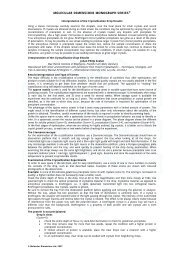(IEA Energy Papers 2011_05) Matthias Finkenrath-Cost and Performance of Carbon Dioxide Capture from Power Generation (IEA Energy Papers)-OECD Publishing (2011)
Create successful ePaper yourself
Turn your PDF publications into a flip-book with our unique Google optimized e-Paper software.
<strong>Cost</strong> <strong>and</strong> <strong>Performance</strong> <strong>of</strong> <strong>Carbon</strong> <strong>Dioxide</strong> <strong>Capture</strong> <strong>from</strong> <strong>Power</strong> <strong>Generation</strong> ©<strong>OECD</strong>/<strong>IEA</strong> <strong>2011</strong><br />
Page | 18<br />
levels. In this study, published cost data are updated to 2010 cost levels using the Chemical<br />
Engineering Plant <strong>Cost</strong> Index, CEPCI (CE, 2010).<br />
In summary, calibration <strong>of</strong> capital cost data includes:<br />
‐ Calibration to overnight costs estimates (by adding owner’s costs or subtracting IDC);<br />
‐ Conversion <strong>of</strong> the original currency to USD; <strong>and</strong><br />
‐ Calibration <strong>of</strong> costs as quoted to 2010 cost levels by using cost indices.<br />
Unless otherwise stated (e.g. with respect to fuel cost assumptions), the same boundary<br />
conditions are applied to all data regardless <strong>of</strong> the location <strong>of</strong> the power plant foreseen by the<br />
authors <strong>of</strong> the studies. Publication years, project locations <strong>and</strong> currencies <strong>of</strong> the reviewed studies<br />
are shown in Table 1.<br />
Table 1. Overview <strong>of</strong> general boundary conditions <strong>of</strong> reviewed studies<br />
Organisation CCP CMU EPRI GCCSI GHG IA NETL NZEC MIT<br />
Publication year(s) 2009<br />
2007,<br />
2009,<br />
2010<br />
2009 2009<br />
2007,<br />
2009<br />
2008,<br />
2010<br />
2009<br />
2007,<br />
2009<br />
Project location EU US US US EU US CHN US<br />
Currency USD USD USD USD USD, EUR USD CNY USD<br />
<strong>Cost</strong> location factors are not applied in this study. Instead, for each data point shown in this<br />
working paper the location <strong>of</strong> the power plant is provided as specified in the original study. This is<br />
helpful since differences in local cost levels, in particular related to labour cost <strong>and</strong> productivity,<br />
are expected for different locations. A sensitivity analysis <strong>of</strong> location‐specific costs for CO 2<br />
capture installations can be found in the literature (GCCSI, 2009).<br />
Conversion <strong>and</strong> calibration <strong>of</strong> performance data<br />
The technical performance <strong>of</strong> power plants with CO 2 capture is typically summarised in terms <strong>of</strong><br />
plant efficiencies, power output <strong>and</strong> CO 2 emissions. Terminology related to performance<br />
evaluation is used consistently throughout techno‐economic studies. Key performance <strong>and</strong><br />
operational parameters reported include the net efficiency or heat rate, the net power output,<br />
specific CO 2 emissions, <strong>and</strong> the plant capacity factor or load factor.<br />
<strong>Performance</strong> estimates in published studies are usually based on fundamental mass <strong>and</strong> energy<br />
balances <strong>from</strong> process flow sheets <strong>of</strong> the power plant <strong>and</strong> the CO 2 capture <strong>and</strong> compression<br />
process. Analyses are commonly based on process simulation as it is typically performed to<br />
assess general feasibility or for front‐end engineering <strong>and</strong> design (FEED) studies. St<strong>and</strong>ardised<br />
(ISO) ambient conditions are usually assumed for the studies.<br />
Nonetheless, important differences in relevant technical assumptions can apply, for example in<br />
terms <strong>of</strong> fuel types or qualities, CO 2 compression <strong>and</strong> pumping discharge pressures, or<br />
assumptions regarding cooling water characteristics (e.g. Zhai, 2010). Due to the complexity <strong>of</strong><br />
the processes or limited detail provided in published information, it was impossible to recalibrate<br />
performance results across the breadth <strong>of</strong> studies under consideration. Though performancerelated<br />
data are not re‐evaluated in this analysis, it is important to note that differences in<br />
performance assumptions can have a substantial impact on results. The potential impact varies




